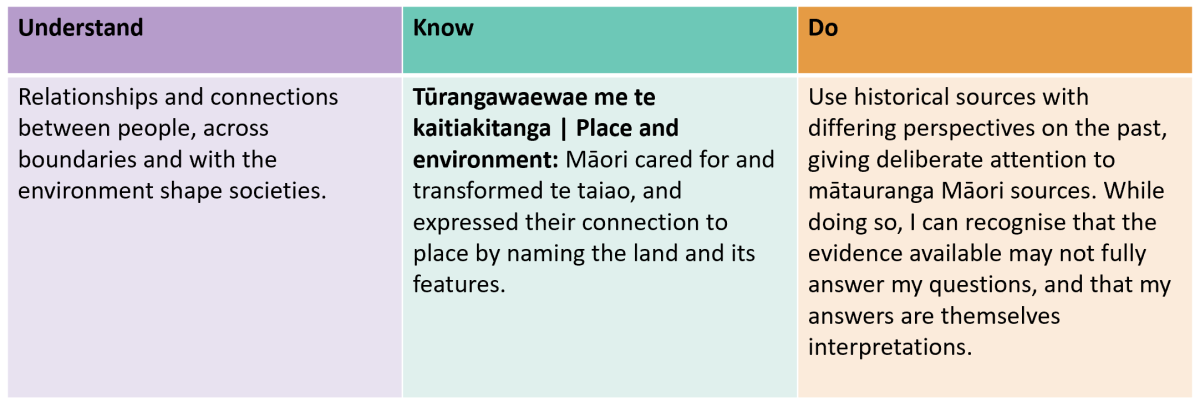<- Homepage: Hīkoi for hauora field trip

New Zealand Curriculum (NZC)
This field trip supports a cross-curricular approach to teaching and learning. It is guided by the 2007 New Zealand Curriculum and Te Mātaiaho –The Refreshed New Zealand Curriculum. It aligns best with, but is not limited to, the learning areas, year groups and progressions presented below.
Select one or more learning areas, concepts and progress outcomes to suit your students’ interests and learning needs.
Use this learning experience as a springboard for multiple areas of inquiry. Look for ways to make connections to learning that matters to students, as well as nationally and locally.
Health and physical education (NZC 2007)
Hauora – a Māori philosophy of well-being that includes the dimensions taha wairua, taha hinengaro, taha tinana, and taha whānau, each one influencing and supporting the others.
Attitudes and values – a positive, responsible attitude on the part of students to their own well-being; respect, care, and concern for other people and the environment; and a sense of social justice.
Personal health and physical development - A (Level 3)
- A1 Personal growth and development - Identify factors that affect personal, physical, social, and emotional growth.
- A2 Regular physical activity - Maintain regular participation in enjoyable physical activities in a range of environments and describe how these assist in the promotion of well-being.
- A4 Personal identity - Describe how their own feelings, beliefs, and actions, and those of other people, contribute to their personal sense of self worth.
Healthy communities and environments - D (Level 3)
- D1 Societal attitudes and values - Identify how health care and physical activity practices are influenced by community and environmental factors.
- D2 Community resources - Participate in communal events and describe how such events enhance the well-being of the community.
Te ao tangata | Refreshed social sciences learning area
Progress outcomes by end of year 8:

Inquiry practice that brings rigour to learning:
Key questions:
- What are the key environmental features of our area?
- Which are at risk and which can provide further opportunities for the community?
Learning experiences – Exploring our place:
- Explore the environmental features of your area and how different groups use and value them.
- Explore the opportunities these features offer and the threats and challenges they face.
- Explore the different ways in which people value and connect with the land and how they affect their actions.
Aotearoa New Zealand's histories (within Te ao tangata)
Progress outcomes by the end of year 8:

Inquiry practice that brings rigour to learning:
Key questions:
- How did Māori express their kinship with, and custodianship of the environment?
- How did naming features of the land express their connection with it?
Learning experiences – Explore examples of:
- how iwi gave expression to their world-view of a deep kinship and holistic relationship between themselves and the natural world
- how the Māori sense of custodianship of the environment was defined by the concepts of whakapapa, manaakitanga, mauri, and kaitiakitanga – for example, through environmental management practices such as rāhui to allow food source to recover, using the maramataka to guide planting and harvesting (e.g., with set times when godwits or eels could be caught), limits on fishing, harvesting only what was needed, laying mauri stones in gardens to protect resources, and leaving gardens fallow
- naming as an expression of connection to places, features of the natural environment, flora, and fauna.
Science (NZC 2007)
The living world strand is about living things and how they interact with each other and the environment. Students develop an understanding of the diversity of life and life processes, of where and how life has evolved, of evolution as the link between life processes and ecology, and of the impact of humans on all forms of life. As a result, they are able to make more informed decisions about significant biological issues. The emphasis is on the biology of New Zealand, including the sustainability of New Zealand’s unique fauna and flora and distinctive ecosystems.
Students will:
- Explain how living things are suited to their particular habitat and how they respond to environmental changes, both natural and human-induced. (Ecology)
English (NZC 2007)
Listening, reading and viewing
Ideas: Show a developing understanding of ideas within, across, and beyond texts.
E.g. Indicators at level 3:
- uses their personal experience and world and literacy knowledge confidently to make meaning from texts
- makes meaning of increasingly complex texts by identifying main and subsidiary ideas in them
- starts to make connections by thinking about underlying ideas in and between texts
- recognises that there may be more than one reading available within a text
- makes and supports inferences from texts with increasing independence.



